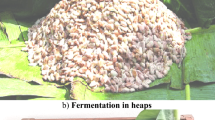Abstract
The effect of biofortified cassava root starch (YfCRS) (90–98 %) and whole egg powder (WEP) (2–10 %) on the pasting, chemical and sensory properties of cassava starch-based custard powder (CbCP) were studied using response surface methodology. The result revealed that there are variations in the pasting properties of the CbCP notwithstanding the levels of WEP inclusion, and all the custard powder could form paste below the boiling point of water at the peak time of <5 min. Additionally, the CbCP with high quantity of WEP had the highest protein (6.39 %), iron (29.39 mg/kg) and zinc (4.25 mg/kg) contents, but with low amylose (18.68 %) and trans-β-carotene (0.0756 μg/g) contents. The YfCRS increased the amylose and trans-β-carotene contents of the custard powder. The models for the responses were highly adequate (R2 > 80 %), except for peak viscosity, pasting temperature, hydrogen cyanide and overall acceptability. Although all the sensory attributes of the formulated CbCP gruel fall within the likeness range, 93.13 % YfCRS and 7.56 % WEP is the optimum combinations for good quality CbCP. Therefore, to replace maize starch with cassava starch in the production of a quality CbCP, 93.13 % YfCRS and 7.56 % WEP could be used.



Similar content being viewed by others
References
O.B. Wurzburg, Modified starches: properties and uses (CRC Press, Boca Raton, 1989). 277
R.N. Echebiri, M.E.I. Edaba, Production and utilization of cassava in Nigeria: prospects for food security and infant nutrition. J. Prod. Agric. Technol. 4(1), 38–52 (2008)
J.T. Nyerhovwo, Cassava and the future of starch. Electron. J. Biotechnol. 7(1), 5–8 (2004)
J.I. Okoye, A.C. Nkwocha, A.O. Agbo, Nutrient composition and acceptability of soy-fortified custard. Cont. J. Food Sci. Technol. 2, 37–44 (2008)
J. Ndife, U.C. Ejikeme, N. Amaechi, Effect of oven drying on the functional and nutritional properties of whole egg and its components. Afr. J. Food Sci. 4(5), 254–257 (2010)
A.V. Vaclavik, W.E. Christain, Essentials of Food Science (Springer, New York, 2008), pp. 205–230
H.G. Bueschelberger, Lecithins, in Emulsifiers in Food Technology, ed. by J.R. Whitehurst (Blackwell Publishing Ltd, Oxford, 2004), pp. 1–22
H.E. Gana, R. Karima, S.K.S. Muhammad, J.A. Bakara, D.M. Hashima, R. Abd. Rahmana, Optimization of the basic formulation of a traditional baked cassava cake using response surface methodology. LWT Food Sci. Technol. 40, 611–618 (2007)
F.J. Colmenero, G. Barreto, N. Mota, J. Carballo, Influence of protein and fat content and cooking temperature on texture and sensory evaluation of bologna sausage. Leb. Wiss. Technol. 28, 481–487 (1995)
S.C. Murphy, D. Gilroy, J.F. Kerry, D.J. Buckley, J.P. Kerry, Evaluation of surimi, fat and water content in a low/no added pork sausage formulation using response surface methodology. Meat Sci. 66, 689–701 (2003)
S. Thakur, D.C. Saxena, Formulation of extruded snack food (gum based cereal-pulse blend): optimization of ingredients levels using response surface methodology. Leb. Wiss. Technol. 33, 354–361 (2000)
A.I. Varnalis, J.G. Brennan, D.B. Macdougall, S.G. Gilmour, Optimization of high temperature puffing of potato cubes using response surface methodology. J. Food Eng. 61, 153–163 (2004)
E. Gallagher, C.M. O’Brien, A.G.M. Scannell, E.K. Arendt, Use of response surface methodology to produce functional short dough biscuits. J. Food Eng. 56, 269–271 (2003)
O.B. Oyewole, N. Obieze, Processing and characteristics of ‘‘Tapioca’’ meal from cassava. Trop. Sci. 35, 19–22 (1995)
Design-Expert, Design-Expert® Version 7.0.0 for Product and Process Optimization. State-Ease, Inc., 2021 East Hennepin Ave., Suite 480 Minneapolis, MN 55413, USA (2005)
Newport Scientific, Applications Manual for the Rapid ViscoTM Analyzer Using Thermocline for Windows. Newport scientific pty Ltd., ½ Apollo Street, Warriewood NSW 2102, Australia, pp. 2–26 (1998)
K. Mohana, U. Asna, N.N. Prasad, Effect of storage on resistant starch and amylose content of cereal-pulse based ready-to-eat commercial products. Food Chem. 102, 1425–1430 (2007)
Foss Analytical A, Manual for Kjeltec System 2300 Distilling and Titration Unit. Kjeldahl Method of Protein Determination (2003)
A.J.A. Essers, M. Bosveld, R.M. Van der Grift, A.G.J. Voragen, Studies on the quantification of specific cyanogens in cassava products and introduction of a new chromogen. J. Sci. Food Agric. 63, 287–296 (1993)
J.R. Jones, J. Benton, C.W. Vernon, Sampling, handling and analyzing plant tissue samples, in Soil Testing and Plant Analysis, 3rd edn., ed. by R.L. Wesbermann (Soil Sci. Soc. Am. Inc, Madison WI, 1990), pp. 389–428
L.M.J. Carvalho, A.R.G. Oliveira, R.L.O. Godoy, S. Pacheco, M.R. Nutti, J.L.V. de Carvalho, E.J. Pereira, W.G. Fukuda, Retention of total carotenoid and b-carotene in yellow sweet cassava (Manihot esculenta Crantz) after domestic cooking. Food Nutr. Res. 56, 15788 (2012)
M.O. Iwe, Sensory Method and Analysis (Rojoint Communication Services, Enugu, 2002), pp. 49–72
SAS, Statistical Analysis Software (SAS) System for Windows, Version 9.1, SAS Institute Inc., Cary, NC, USA (2008)
B. Maziya-Dixon, A.G.O. Dixon, A.A. Adebowale, Targeting different end uses of cassava: genotypic variations for cyanogenic potentials and pasting properties. Int. J. Food Sci. Technol. 42, 969–976 (2007)
M.L. Dreher, J.W. Berry, Buffalo gourd root starch. Part I. Properties and structure. Starch/Starke 35, 76–81 (1983)
A.A. Adebowale, L.O. Sanni, S.O. Awonorin, Effect of texture modifiers on the physicochemical and sensory properties of dried fufu. Food Sci. Technol. Int. 11(5), 373–382 (2005)
FAO/WHO, Joint FAO/WHO food standards programme. In: Codex Alimentarius Commission XII (Suppl. 4). (FAO, Rome, 1991)
Acknowledgments
The International Institute of Tropical Agriculture (IITA) Ibadan, Nigeria, supplied the Yellow-fleshed Cassava Roots used for this work. We especially acknowledge Drs. P. Kulakow and G. Badara of IITA for their contributions to this work.
Author information
Authors and Affiliations
Corresponding author
Ethics declarations
Conflict of interest
There is no conflict of interest.
Rights and permissions
About this article
Cite this article
Awoyale, W., Sanni, L.O., Shittu, T.A. et al. The pasting, chemical and sensory properties of biofortified cassava root starch-based custard powder. Food Measure 10, 292–301 (2016). https://doi.org/10.1007/s11694-016-9306-3
Received:
Accepted:
Published:
Issue Date:
DOI: https://doi.org/10.1007/s11694-016-9306-3




